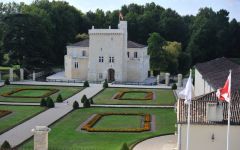Chateau La Tour Carnet 2020
-
James
Suckling -
Wine
Enthusiast - Decanter
-
Robert
Parker -
Jeb
Dunnuck



Product Details
Your Rating
Somm Note
Winemaker Notes
Chateau La Tour Carnet 2020 is a very deep, with a brilliant ruby red color. The first nose is very fruity with notes of ripe fruit, in particular blackcurrant and blackberry. This perception becomes more complex when stirred with vanilla notes that underline the fruity perception. On the palate, we quickly notice the silky and the finesse of the tannins which give a very elegant density and good balance. The evolution is powerful but controlled until the long and smooth finish.
Professional Ratings
-
James Suckling
Tight and linear with blackcurrant and lemon rind character. Medium-bodied and racy with very fine tannins and a bright finish. Shows energy and focus. Drinkable, but better in three or four years.
-
Wine Enthusiast
This magnificent medieval castle controls a vineyard that is just inland from Saint-Julien. With its ripe perfumes and rich tannins, the wine has a powerful potential set against the tightly juicy black currant fruits.
Barrel Sample: 92-94 -
Decanter
They have done a good job of carefully working the extraction so that the tannins are abundant but not bitter, and the fruit is savory, with layers of redcurrant and raspberry alongside some hawthorn character. Expertly handled, lovely appealing aromatics, but things finish a little abruptly.
Barrel Sample: 91 -
Robert Parker's Wine Advocate
Aromas of raspberries, crème de cassis, cigar wrapper and loamy soil introduce the 2020 La Tour Carnet, a medium to full-bodied, velvety and polished wine that's more harmonious and better balanced than Magrez's Grands Chênes. This large estate has eaten up many of the Haut-Médoc's non-classified growths over the past decade to arrive at a surface area of over 130 hectares today. Best after 2023.
-
Jeb Dunnuck
Almost always a winner, the 2020 Chateau La Tour Carnet offers a terrific, medium-bodied, concentrated style as well as classic notes of ripe currants, darker cherries, spicy wood, and graphite. It has the vintage's more focused, classic, structured style, with ripe tannins and outstanding length. It's well worth seeking out and is going to evolve for at least a decade. Best After 2023.
Other Vintages
2022-
James
Suckling - Decanter
-
Wine
Spectator - Decanter
-
Robert
Parker -
James
Suckling
-
James
Suckling -
Robert
Parker -
Jeb
Dunnuck -
Wine
Spectator
-
Wine
Enthusiast - Decanter
-
James
Suckling -
Robert
Parker -
Wine
Spectator -
Jeb
Dunnuck
-
James
Suckling - Decanter
-
Robert
Parker
-
Wine
Enthusiast -
James
Suckling -
Robert
Parker -
Tasting
Panel -
Wine
Spectator
-
Wine
Spectator -
Robert
Parker
-
Robert
Parker -
Wine
Enthusiast -
James
Suckling
-
Robert
Parker -
Wine
Enthusiast -
James
Suckling
-
Robert
Parker
-
Robert
Parker -
Connoisseurs'
Guide -
Wine
Spectator
-
Wine
Enthusiast -
Wine
Spectator -
Robert
Parker -
Connoisseurs'
Guide
-
Wine
Enthusiast -
Robert
Parker
-
Robert
Parker




One of the world’s most classic and popular styles of red wine, Bordeaux-inspired blends have spread from their homeland in France to nearly every corner of the New World. Typically based on either Cabernet Sauvignon or Merlot and supported by Cabernet Franc, Malbec and Petit Verdot, the best of these are densely hued, fragrant, full of fruit and boast a structure that begs for cellar time. Somm Secret—Blends from Bordeaux are generally earthier compared to those from the New World, which tend to be fruit-dominant.

While it claims the same basic landscape as the Medoc—only every so slightly elevated above river level—the Haut Medoc is home to all of the magnificent chateaux of the Left Bank of Bordeaux, creating no lack of beautiful sites to see.
These chateaux, residing over the classed-growth cru in the villages of Margaux, Moulis, Listrac, St-Julien, Pauillac and St. Estephe are within the Haut Medoc appellation. Though within the confines of these villages, any classed-growth chateaux will most certainly claim village or cru status on their wine labels.
Interestingly, some classed-growth cru of the Haut Medoc fall outside of these more famous villages and can certainly be a source of some of the best values in Bordeaux. Deep in color, and concentrated in ripe fruit and tannins, these wines (typically Cabernet Sauvignon-based) often prove the same aging potential of the village classed-growths. Among these, the highest ranked chateaux are Chateau La Lagune and Chateau Cantemerle.
